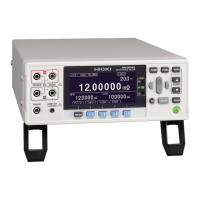5.4 Performing Temperature Rise Test (Temperature Conversion Function (T))
116
The temperature conversion principle is used to derive temperature increase over time.
This functionality allows the temperature during normal stops and other data to be esti-
mated.
See: "Appendix 5 Temperature Conversion (T) Function" (p. A6)
To perform temperature conversion, connect the Z2001 Temperature Sensor to the TEMP.
jack on the rear of the instrument. Before connecting the sensor, read the following.
See: "Connecting the Z2001 Temperature Sensor"(p.37)
"Connecting an Analog Output Thermometer"(p.39)
"3.1 Checking the Measurement Target" (p.48)
When T is set to ON, the comparator function cannot be turned ON.
When TC, the BIN measurement function, or the statistical calculation function is set to on,
T is automatically set to off.
Example temperature rise test
(1) After the motor and coil are stabilized at room temperature, measure the resistance (R
1
)
and instrument ambient temperature (t
1
), and then input these values to the instrument.
(p.117)
(2) Disconnect the test lead from the measurement target.
(3) After turning off the power, reconnect the test lead to the measurement target and then
measure the temperature rise value (t
1
to t
n
) at the preset intervals.
(4) Draw a line by connecting the collected temperature data (t
1
to t
n
), and estimate the
maximum temperature rise value (t ).
5.4 Performing Temperature Rise Test
(Temperature Conversion Function (T))
Initial temp.
Temp.
t
t
1
t
2
t
n
(1) (2) (3)
(4)
Time
ON Power Off 1 2 3 . . . . . . n

